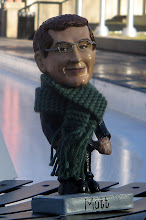The dog runs ahead, prancing and looking back, knowing the way we are about to go. This is a walk well established with us - a route in our minds as well as on the ground. There is a sort of mystery in the establishment of these ways. Anytime one crosses a given stretch of country with some frequency, no matter how wanderingly one begins, the tendency is always toward habit. By the third or fourth trip, without realizing it, one is following a fixed path, going the way one went before. After that, one may still wander, but only by deliberation, and when there is reason to hurry, or when the mind wanders rather than the feet, one returns to the old route. Familiarity has begun. One has made a relationship with the landscape, and the form and the symbol and the enactment of the relationship is the path. These paths of mine are seldom worn on the ground. They are habits of mind, directions and turns. They are as personal as old shoes. My feet are comfortable in them.
- Wendell Berry, from "A Native Hill," collected in The Art of the Commonplace, p. 14
Lately my practicing has been rather unstructured, casually wandering from Bach to Tubin, maybe grazing on an excerpt or two in passing. It's a pleasure to practice this way for a few days, to recapture the simple joy of filling a room with sounds. Though as Wendell Berry writes, we tend to set up habits even when we don't realize it.
At one time or another I've probably worked fairly intensely on each of the Bach cello suites, but just a few movements have made a place in my everyday routine. They risk getting worn and stale, and my excuses are a bit stale as well: audition preparation, the pressure to specialize, the fact that they're just damn hard. Yeah, and I guess I do pick favorites, even when it's all some of the greatest music ever written. (BTW, I read recently that a professor in Australia has hypothesized that the cello suites are Anna Magdalena's work, not Johann Sebastian's - though few scholars agree.)
There's nothing wrong with a well-worn habit, as long as it doesn't get too deeply fixed, and the path becomes a road (or a rut). Here's Wendell Berry again:
The difference between a path and a road is not only the obvious one. A path is littel more than a habit that comes with knowledge of a place. It is a sort of ritual of familiarity. As a form, it is a form of contact with a known landscape. It is not destructive. It is the perfect adaptation, through experience and familiarity, of movement to place; it obeys the natural contours; such obstacles as it meets it goes around. A road, on the other hand, even the most primitive road, embodies a resistance against the landscape. Its reason is not simply the necessity for movement, but haste. Its wish is to avoid contact with the landscape; it seeks so far as possible to go over the country, rather than through it; its aspiration, as we see clearly in the example of the modern freeways, is to be a bridge; its tendency is to translate place into space in order to traverse it with the least effort. It is destructive, seeking to remove or destroy all obstacles in its way. The primitive road advanced by the destruction of the forest; modern roads advance by the destruction of topography.
- p. 12
And to continue the analogy, I guess a rut advances by the destruction of music, in our haste to get through it. Today is the 50th anniversary of the creation of the interstate highway system, and while we may love or hate our freeways - depending on how fast they're moving, and how much of a hurry we're in - no one wants to live on an interstate. Or make music that sounds and feels like one. So the challenge is to keep our practice like a path, comfortable and familiar, but always in contact with the landscape of the music, and ready to veer into the unknown when our interest and opportunities arise.
I decided to start some new paths through the Bach suites; yesterday I worked through all six preludes, and today I did all of the allemandes. I'm not sure what inspired me to do it this way, but I did uncover some interesting connections, even as I realized how different these pieces are (and how little I know some of them!) It felt at times like wandering through uncharted forest, searching for patterns and trying to avoid tripping over stray accidentals. At least my mind wasn't wandering too much though, and it made me want to form my relationship with these pieces all over again.






